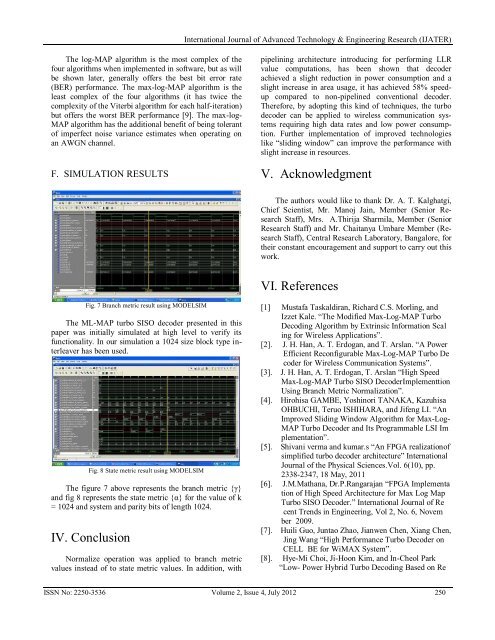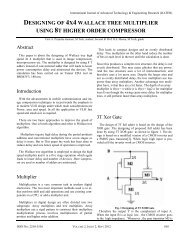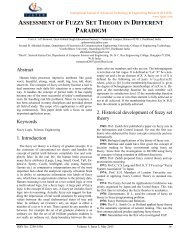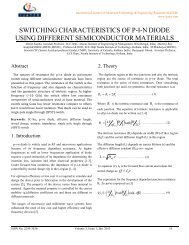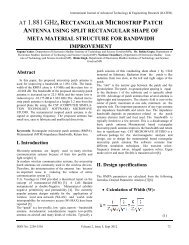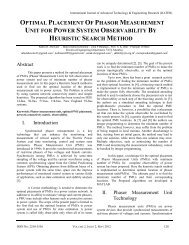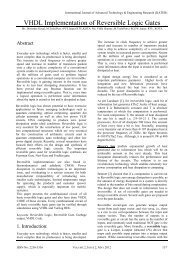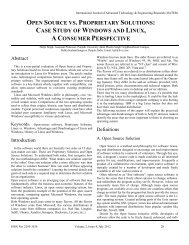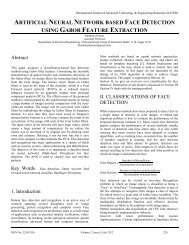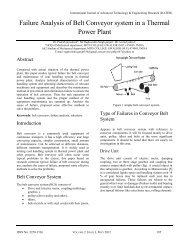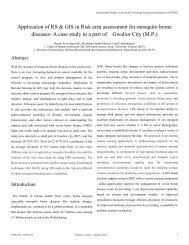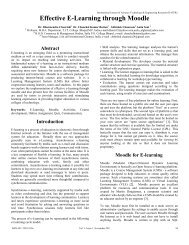implementation of turbo decoder using max-log-map ... - ijater
implementation of turbo decoder using max-log-map ... - ijater
implementation of turbo decoder using max-log-map ... - ijater
You also want an ePaper? Increase the reach of your titles
YUMPU automatically turns print PDFs into web optimized ePapers that Google loves.
International Journal <strong>of</strong> Advanced Techno<strong>log</strong>y & Engineering Research (IJATER)<br />
The <strong>log</strong>-MAP algorithm is the most complex <strong>of</strong> the<br />
four algorithms when implemented in s<strong>of</strong>tware, but as will<br />
be shown later, generally <strong>of</strong>fers the best bit error rate<br />
(BER) performance. The <strong>max</strong>-<strong>log</strong>-MAP algorithm is the<br />
least complex <strong>of</strong> the four algorithms (it has twice the<br />
complexity <strong>of</strong> the Viterbi algorithm for each half-iteration)<br />
but <strong>of</strong>fers the worst BER performance [9]. The <strong>max</strong>-<strong>log</strong>-<br />
MAP algorithm has the additional benefit <strong>of</strong> being tolerant<br />
<strong>of</strong> imperfect noise variance estimates when operating on<br />
an AWGN channel.<br />
F. SIMULATION RESULTS<br />
pipelining architecture introducing for performing LLR<br />
value computations, has been shown that <strong>decoder</strong><br />
achieved a slight reduction in power consumption and a<br />
slight increase in area usage, it has achieved 58% speedup<br />
compared to non-pipelined conventional <strong>decoder</strong>.<br />
Therefore, by adopting this kind <strong>of</strong> techniques, the <strong>turbo</strong><br />
<strong>decoder</strong> can be applied to wireless communication systems<br />
requiring high data rates and low power consumption.<br />
Further <strong>implementation</strong> <strong>of</strong> improved techno<strong>log</strong>ies<br />
like “sliding window” can improve the performance with<br />
slight increase in resources.<br />
V. Acknowledgment<br />
The authors would like to thank Dr. A. T. Kalghatgi,<br />
Chief Scientist, Mr. Manoj Jain, Member (Senior Research<br />
Staff), Mrs. A.Thirija Sharmila, Member (Senior<br />
Research Staff) and Mr. Chaitanya Umbare Member (Research<br />
Staff), Central Research Laboratory, Bangalore, for<br />
their constant encouragement and support to carry out this<br />
work.<br />
VI. References<br />
Fig. 7 Branch metric result <strong>using</strong> MODELSIM<br />
The ML-MAP <strong>turbo</strong> SISO <strong>decoder</strong> presented in this<br />
paper was initially simulated at high level to verify its<br />
functionality. In our simulation a 1024 size block type interleaver<br />
has been used.<br />
Fig. 8 State metric result <strong>using</strong> MODELSIM<br />
The figure 7 above represents the branch metric {γ}<br />
and fig 8 represents the state metric {α} for the value <strong>of</strong> k<br />
= 1024 and system and parity bits <strong>of</strong> length 1024.<br />
IV. Conclusion<br />
Normalize operation was applied to branch metric<br />
values instead <strong>of</strong> to state metric values. In addition, with<br />
[1] Mustafa Taskaldiran, Richard C.S. Morling, and<br />
Izzet Kale. “The Modified Max-Log-MAP Turbo<br />
Decoding Algorithm by Extrinsic Information Scal<br />
ing for Wireless Applications”.<br />
[2]. J. H. Han, A. T. Erdogan, and T. Arslan. “A Power<br />
Efficient Reconfigurable Max-Log-MAP Turbo De<br />
coder for Wireless Communication Systems”.<br />
[3]. J. H. Han, A. T. Erdogan, T. Arslan “High Speed<br />
Max-Log-MAP Turbo SISO DecoderImplementtion<br />
Using Branch Metric Normalization”.<br />
[4]. Hirohisa GAMBE, Yoshinori TANAKA, Kazuhisa<br />
OHBUCHI, Teruo ISHIHARA, and Jifeng LI. “An<br />
Improved Sliding Window Algorithm for Max-Log-<br />
MAP Turbo Decoder and Its Programmable LSI Im<br />
plementation”.<br />
[5]. Shivani verma and kumar.s “An FPGA realization<strong>of</strong><br />
simplified <strong>turbo</strong> <strong>decoder</strong> architecture” International<br />
Journal <strong>of</strong> the Physical Sciences.Vol. 6(10), pp.<br />
2338-2347, 18 May, 2011<br />
[6]. J.M.Mathana, Dr.P.Rangarajan “FPGA Implementa<br />
tion <strong>of</strong> High Speed Architecture for Max Log Map<br />
Turbo SISO Decoder.” International Journal <strong>of</strong> Re<br />
cent Trends in Engineering, Vol 2, No. 6, Novem<br />
ber 2009.<br />
[7]. Huili Guo, Juntao Zhao, Jianwen Chen, Xiang Chen,<br />
Jing Wang “High Performance Turbo Decoder on<br />
CELL BE for WiMAX System”.<br />
[8]. Hye-Mi Choi, Ji-Hoon Kim, and In-Cheol Park<br />
“Low- Power Hybrid Turbo Decoding Based on Re<br />
ISSN No: 2250-3536 Volume 2, Issue 4, July 2012 250


